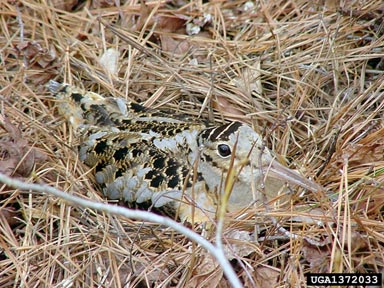SCIENTIFIC NAME:
Scolopax minor
OTHER NAMES:
Timberdoodle, wood snipe, bog sucker, night partridge.
STATUS:
Breeder. Fairly common in fall and winter, and occasional in spring and summer in Gulf Coast region. Uncommon in winter, spring, and fall, and rare in summer in other regions. MODERATE CONSERVATION CONCERN.
DESCRIPTION:
American woodcocks, Scolopax minor, are short, plump birds with long bills and large eyes set high, and far back on the head. The head appears to sit on the body with no neck. The two- to three-inch long bill has a flexible tip. The female is larger than the male and has a longer bill. Plumage of both sexes is a “dead leaf” camouflage pattern of mixed brown, buff, gray and black. American woodcocks are 10 to 12 inches in length with a wingspan of up to 19 inches.
DISTRIBUTION:
As a migratory bird, the American woodcock lives in the North during spring and summer but spends the cold months in the South. There are two major woodcock populations in North America, with each inhabiting a separate region: the eastern region is from the Appalachian Mountains eastward; and the central region is from west of the Appalachians to the Great Plains.
HABITAT:
Woodcocks are attracted to moist, young forest and require young, dense woodlands to provide ample cover and food resources. They tend to use edges rather than the interior of big, even-age thickets. Courtship sites in spring consist of forest clearings, abandoned fields with low brush, or open fields next to forest edges.
FEEDING HABITS:
The flexible tip of the woodcock’s bill is specialized for catching earthworms. The bird probably feels worms as it probes in the ground. A woodcock may rock its body back and forth without moving its head as it slowly walks around, stepping heavily with its front foot. This action may cause worms to move around in the soil making them easier to detect. In addition to earthworms, woodcock may feed on insect larvae, slugs, snails, insects, and some seeds such as alder, smartweed, dogwood, and blackberry. An adult woodcock may eat its weight in worms every day.
LIFE HISTORY AND ECOLOGY:
Known as a shorebird that lives in the forest, the American woodcock is most frequently encountered at dusk when the male’s chirping, peenting aerial displays attract attention. The male uses an elaborate display to attract females. At sunset he flies to the singing grounds and gives a nasal, buzzing insect-like note usually described as a “peent,” which may be repeated up to 200 times in a five minute period. After a short time, he flies upward in a wide spiral. As he gets higher, his wings make a loud whistling noise. After reaching a height of 200 to 300 feet the whistling becomes intermittent, and the bird starts chirping as he starts to descend. He comes down in a zigzag, diving fashion, chirping as he goes. He may repeat this display over and over for a half hour or longer. Males may mate with several different individuals during the mating season.
The female woodcock makes a shallow depression in leaf litter, usually less than three feet from the base of a tree or shrub. Nesting normally occurs from early March to June but may begin earlier in the Deep South. The female will lay one egg a day until she completes the normal clutch of four. The eggs are oval and may vary from pinkish-buff to cinnamon with brown blotches and darker specking. The incubation process takes 19 to 22 days. The male plays no role in nest selection, incubation, or rearing of the young. American woodcock chicks are precocial, meaning they are able to leave the nest within a few hours after hatching. The chicks are well-camouflaged and will “freeze” when threatened or in response to the hen’s alarm call. The chicks grow rapidly and can fly after two weeks and are almost fully grown in four weeks. The family breaks up when the chicks are six to eight weeks old.
REFERENCES:
Keppie, D.M., and R.M. Whiting, Jr. 1994. American Woodcock (Scolocpax minor). In The Birds of North America, No. 100 (A. Poole, and F.Gill, eds.). The Academy of Natural Sciences, Philadelphia, PA, and The American Ornithologists’ Union, Washington, D.C.
Ohio Department of Natural Resources. Division of Wildlife. Life History Notes for American Woodcock. Publication 313 (901)
The Ruffed Grouse Society
AUTHOR:
Joel Glover, Wildlife Biologist, Division of Wildlife and Freshwater Fisheries






